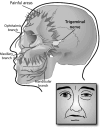Exploring the Connection Between Sleep and Cluster Headache: A Narrative Review
- PMID: 32382871
- PMCID: PMC7648820
- DOI: 10.1007/s40122-020-00172-6
Exploring the Connection Between Sleep and Cluster Headache: A Narrative Review
Abstract
Cluster headache is a rare form of headache associated with sleep and even speculated to be a manifestation of a sleep disorder rather than a primary headache. Cluster headache exhibits both circadian and circannual rhythmicity. While attacks often occur during sleep, the implication that cluster headaches might be involved with rapid eye movement (REM) sleep phases has neither been fully established nor refuted. The regulatory mechanisms governing sleep including hypothalamic activity and the autonomic nervous system response may play a role. Hypothalamic activation has been observed in cluster headache patients during positron emission tomography testing, but only during attacks. While sleep apnea is associated with morning headaches in general, the link between sleep-disordered respiration and cluster headache remains elusive. Hypoarousal during sleep and periods of hypoxia are associated with cluster headache, the latter likely involving inflammatory processes rather than apnea. Further study is needed, as cluster headaches represent a serious primary cephalgia that is incompletely understood.
Keywords: Chronic cluster headache; Cluster headache; Cluster headache syndrome; Sleep.
Conflict of interest statement
Peter Magnusson, Jo Ann LeQuang, Charles Wollmuth, Robert Taylor, Jr. and Frank Breve have nothing to disclose. Joseph V. Pergolizzi, Jr. is a member of the journal’s Editorial Board.
Figures


Similar articles
-
Sleep-related headache and its management.Curr Treat Options Neurol. 2013 Dec;15(6):704-22. doi: 10.1007/s11940-013-0258-1. Curr Treat Options Neurol. 2013. PMID: 24132786
-
Rare nocturnal headaches.Curr Opin Neurol. 2004 Jun;17(3):295-9. doi: 10.1097/00019052-200406000-00010. Curr Opin Neurol. 2004. PMID: 15167064 Review.
-
Sleep apnea in cluster headache.Cephalalgia. 1984 Mar;4(1):33-8. doi: 10.1046/j.1468-2982.1984.0401033.x. Cephalalgia. 1984. PMID: 6713522
-
Neurobiology and sleep disorders in cluster headache.J Headache Pain. 2015;16:562. doi: 10.1186/s10194-015-0562-0. Epub 2015 Aug 20. J Headache Pain. 2015. PMID: 26289164 Free PMC article. Review.
-
Sleep in cluster headache - beyond a temporal rapid eye movement relationship?Eur J Neurol. 2015 Apr;22(4):656-e40. doi: 10.1111/ene.12623. Epub 2014 Dec 30. Eur J Neurol. 2015. PMID: 25557272
Cited by
-
Cluster Headache: Clinical Characteristics and Opportunities to Enhance Quality of Life.Curr Pain Headache Rep. 2021 Oct 19;25(10):65. doi: 10.1007/s11916-021-00979-8. Curr Pain Headache Rep. 2021. PMID: 34668084 Review.
-
Orexins and primary headaches: an overview of the neurobiology and clinical impact.Expert Rev Neurother. 2024 May;24(5):487-496. doi: 10.1080/14737175.2024.2328728. Epub 2024 Mar 22. Expert Rev Neurother. 2024. PMID: 38517280 Free PMC article. Review.
-
Phenotype of Cluster Headache: Clinical Variability, Persisting Pain Between Attacks, and Comorbidities-An Observational Cohort Study in 825 Patients.Pain Ther. 2021 Dec;10(2):1121-1137. doi: 10.1007/s40122-021-00267-8. Epub 2021 May 4. Pain Ther. 2021. PMID: 33945123 Free PMC article.
-
Hyperalgesia, Increased Temporal Summation and Impaired Inhibitory Mechanisms in Episodic and Chronic Cluster Headache: An Observational Study.Biomedicines. 2024 Feb 6;12(2):374. doi: 10.3390/biomedicines12020374. Biomedicines. 2024. PMID: 38397976 Free PMC article.
-
Headache Phenotype and the Psychosocial Burden of Cluster Headaches: An Analysis of Patients Prior to Hospitalization.Pain Ther. 2025 Apr;14(2):753-767. doi: 10.1007/s40122-025-00715-9. Epub 2025 Feb 24. Pain Ther. 2025. PMID: 39994092 Free PMC article.
References
-
- Olesen J. The international classification of headache disorders, 2nd edition: application to practice. Funct Neurol. 2005;20:61–68. - PubMed
-
- Fischera M, Marziniak M, Gralow I. The incidence and prevalence of cluster headache: a meta-analysis of population-based studies. Cephalgia. 2008;28:614–618. - PubMed
-
- Baharav A, Shinar Z, Akselrod S, Mosek A, Davrath LR. Cluster headache patients have normal circadian and sleep time autonomic nervous system function. IEEE. 2005;2005:263–266.
-
- Barloese M, Lund N, Petersen A, Rasmussen M, Jennum P, Jensen R. Sleep and chronobiology in cluster headache. Cephalalgia. 2015;35(11):969–978. - PubMed
-
- Holland PR, Goadsby PJ. Cluster headache, hypothalamus, and orexin. Curr Pain Headache Rep. 2009;13(2):147–154. - PubMed
Publication types
LinkOut - more resources
Full Text Sources

